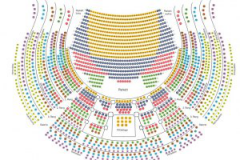Duato, Skeels, Eyal Ballet
Mo | Tu | We | Th | Fr | Sa | Su |
Sometimes you want to escape the world - the three choreographies in this new Triple Bill, which opens the Ballettfestwoche 2024, revolve around various forms of escapism. Following Bedroom Folk by Sharon Eyal, which was first shown at the Bayerisches Staatsballett as part of Paradigma in 2020, Autodance is the second work by the Israeli-born choreographer and her artistic partner Gai Behar. With the Greek prefix "auto", Eyal refers to a dance that draws its energy from itself. Ori Lichtik has created an electronic, multi-layered beat, which brings to mind excessive party nights and supernatural harmonies of the spheres.
For Nacho Duato, the trigger for White Darkness was the death of one of his sisters. The work was created for the Compañía Nacional de Danza in Madrid and deals with the fatal pull of intoxicants. It is accompanied by works for string quartet and string orchestra by Karl Jenkins.
The world premiere of Chasm was created by North American Andrew Skeels, who is working with the Bayerisches Staatsballett for the first time. His choreographic language is characterised by a cinematic aesthetic that is characterised by speed and a desire to take risks. The basis for this work, which can be seen in the centre section of the ballet evening, is a science fiction scenario: thousands of years in the future, a new human species has developed in an evolutionary process. It lives in a cave system and has developed its own form of communication via a mycelium-like network. Due to climatic changes, the community has to radically change its way of life and break out of the cave. They develop a ritual with which these people actually succeed in causing a brake ("chasm"). In the end, they have to realise that their hopes were in vain. The science fiction scenario is accompanied by the cinematic sounds of composer Antoine Seychal.
Program and cast
White Darkness (2001)
Choreography - Nacho Duato
Music - Karl Jenkins
Set Design - Jaafar Chalabi
Costume Design - Lourdes Frías
Lighting - Joop Caboort
Stager - Thomas Klein
Andrew Skeels: Chasm
Choreography - Andrew Skeels
Music - Antoine Seychal
Costume Design - Marija Djordjevic
Set Design - Michel Ostaszewski
Lighting - Christian Kass
Assistant Choreographer - Jean-Sébastien Couture, Nicolas Grosclaude
Autodance (2018)
Choreography - Sharon Eyal
Assistant Choreographer - Gai Behar
Music - Ori Lichtik
Costume Design - Rebecca Hytting
Lighting - Alon Cohen
Stager - Olivia Ancona
National Theatre Munich
The National Theatre Munich (German: Nationaltheater München) is an opera house in Max-Joseph-Platz in Munich, Germany. It is the home of the Bavarian State Opera and the Bayerisches Staatsballett(Bavarian State Ballet).
The Bavarian State Opera also performs in the Prinzregententheater, which opened in 1901 and, like the Bayreuth Festspielhaus, is built to Richard Wagner's specifications, and in the Cuvilliés Theatre at the Residenz, constructed in 1751–1753 and described by Thierry Beauvert as "a Rococo gem".
The Nationaltheater is very easy to get to both by car and by MVV public transportation.
By MVV public transportation
S-Bahn: S 1 - 8 Marienplatz
U-Bahn: U 3, 6 Marienplatz, U 3 - 6 Odeonsplatz
Bus: 52, 131 Marienplatz, 100 Odeonsplatz
Straßenbahn: 19 Nationaltheater
On the day of the performance, holders of regular tickets are entitled to use public transport provided by the Münchner Verkehrsverbund (MVV). This service starts at 3 pm respectively three hours before the performance commences and ends with the closing hour of the MVV.
By Car
Take the Altstadt-Ring to Maximilianstraße.
Parking garage Max-Joseph-Platz: open Monday to Sunday from 6:00 A.M. to 2:00 A.M.
You can take advantage of the special theatre parking fee of Euro 10,- from 6:00 P.M. to 8:00 A.M. by presenting your admission tickets.

 EN
EN DE
DE IT
IT FR
FR ES
ES RU
RU JP
JP RO
RO
 Seating plan
Seating plan 